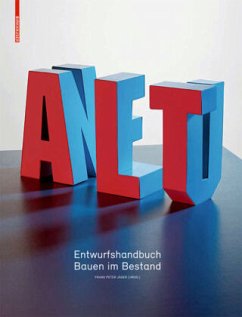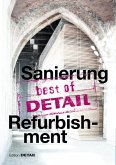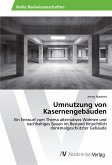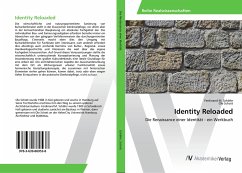Most of the buildings that will be needed in Europe in the coming decades have long since been built. The building tasks of the future lie in the skillful reuse and transformation of existing building stock, whether it be the redevelopment of historic city centers, the building of extensions onto residential structures, the expansion of public buildings, or the redevelopment of entire factory areas. Building in the existing fabric calls for highly specific approaches in planning, construction, and implementation. It spans a broad range of building tasks, from working within the guidelines of historic preservation and renovating carefully and cautiously all the way to the complete transformation of what exists. In addition to aesthetic transformation, technical aspects such as improving energy efficiency and working with contaminated building materials also play an important role.
This book provides a comprehensive overview of architectonic strategies of "continuing to build." It presents intelligent ideas and approaches for working with existing building stock and divides them into three categories according to the method selected: addition, transformation, and reuse. Presented in this volume are everyday projects such as the revitalizing of structures from the 1950s to the 1970s – for example, the renovation of Siedlung Heuried in Zurich by Adrian Streich Architekten – but also more specialized examples such as the open-air library made of elements recycled from the façade of a department store in Magdeburg-Salbke by Karo* Architekten. Interviews with experts provide helpful background information on selected topics.
Die meisten Gebäude, die in den nächsten Jahrzehnten in Europa benötigt werden, sind längst gebaut. Die Bauaufgaben der Zukunft liegen in der geschickten (Um-)Nutzung und Veränderung von Bestehendem, ob bei der Sanierung von Altstädten, beim Anbau an Wohnhäuser, bei der Erweiterung öffentlicher Gebäude oder der Umnutzung ganzer Fabrikareale. Das Bauen im Bestand erfordert spezifische Vorgehensweisen bei Planung, Bauausführung und Umsetzung. Die Bandbreite reicht dabei vom Arbeiten mit den Vorgaben des Denkmalschutzes, dem behutsamen Sanieren, bis hin zum vollständigen Überformen des Vorgefundenen. Neben der ästhetischen Transformation spielen auch technische Aspekte wie die energetische Ertüchtigung oder der Umgang mit kontaminierten Baustoffen eine wichtige Rolle.
Das Buch liefert einen umfassenden Überblick über architektonische Strategien des "Weiterbauens". Es präsentiert intelligente Ideen und Konzepte für den Umgang mit dem Bestand und gliedert diese entsprechend der gewählten Herangehensweise in drei Kategorien: Addition, Transformation oder Umnutzung. Vorgestellt werden alltägliche Projekte wie die Revitalisierung von Bauten der Fünfziger bis Siebziger Jahre, etwa die von Adrian Streich Architekten sanierte Siedlung Heuried in Zürich, aber auch besondere Beispiele wie die Freiluftbibliothek aus recycelten Elementen einer Kaufhausfassade in Magdeburg-Salbke von Karo_ Architekten. Interviews mit Experten liefern hilfreiche Hintergrundinformationen zu ausgewählten Themen.
This book provides a comprehensive overview of architectonic strategies of "continuing to build." It presents intelligent ideas and approaches for working with existing building stock and divides them into three categories according to the method selected: addition, transformation, and reuse. Presented in this volume are everyday projects such as the revitalizing of structures from the 1950s to the 1970s – for example, the renovation of Siedlung Heuried in Zurich by Adrian Streich Architekten – but also more specialized examples such as the open-air library made of elements recycled from the façade of a department store in Magdeburg-Salbke by Karo* Architekten. Interviews with experts provide helpful background information on selected topics.
Die meisten Gebäude, die in den nächsten Jahrzehnten in Europa benötigt werden, sind längst gebaut. Die Bauaufgaben der Zukunft liegen in der geschickten (Um-)Nutzung und Veränderung von Bestehendem, ob bei der Sanierung von Altstädten, beim Anbau an Wohnhäuser, bei der Erweiterung öffentlicher Gebäude oder der Umnutzung ganzer Fabrikareale. Das Bauen im Bestand erfordert spezifische Vorgehensweisen bei Planung, Bauausführung und Umsetzung. Die Bandbreite reicht dabei vom Arbeiten mit den Vorgaben des Denkmalschutzes, dem behutsamen Sanieren, bis hin zum vollständigen Überformen des Vorgefundenen. Neben der ästhetischen Transformation spielen auch technische Aspekte wie die energetische Ertüchtigung oder der Umgang mit kontaminierten Baustoffen eine wichtige Rolle.
Das Buch liefert einen umfassenden Überblick über architektonische Strategien des "Weiterbauens". Es präsentiert intelligente Ideen und Konzepte für den Umgang mit dem Bestand und gliedert diese entsprechend der gewählten Herangehensweise in drei Kategorien: Addition, Transformation oder Umnutzung. Vorgestellt werden alltägliche Projekte wie die Revitalisierung von Bauten der Fünfziger bis Siebziger Jahre, etwa die von Adrian Streich Architekten sanierte Siedlung Heuried in Zürich, aber auch besondere Beispiele wie die Freiluftbibliothek aus recycelten Elementen einer Kaufhausfassade in Magdeburg-Salbke von Karo_ Architekten. Interviews mit Experten liefern hilfreiche Hintergrundinformationen zu ausgewählten Themen.








